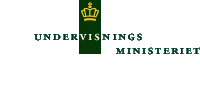
Chapter 4
Democracy as a Necessary Prerequisite
Inform Others of Your Work
By Birthe Zimmermann
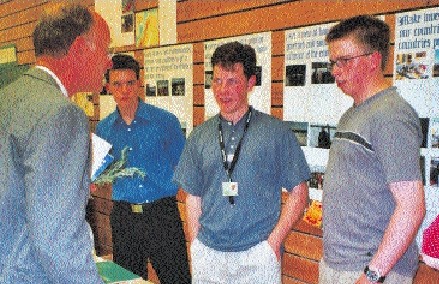
Presenting your work to others leads to empowerment and action
competence
For the enhancement of action competence, workshops on the Baltic 21 sectors or on integrated sector work serve this purpose. Part of a person’s involves being able to inform others of the outcome and results of one’s work. All participants at the "On the Threshold – Baltic 21" conference had to be prepared before the activities took place. Each workshop was considered an integrated unit, and the workshop members therefore consisted of students, teachers, co-ordinators and politicians competence, or on inte-purpose. Part of a inform others work.
Threshold – prepared before workshop was and the work- of students, politicians co-operating and working together. The workshops thus had participants of mixed age groups, opinions and nationalities.
Included in the workshop tasks was a photo competition, where each workshop had a camera with 36 shots and was asked to nominate its best photo in the following three categories:
- “On Baltic 21”
- “Among friends”
- “?” – Define the title within your workshop and
state why you named it accordingly.” Preparing the dialogue
with politicians was like-wise an integrated task. Participants
developed skills on:
- how to formulate questions
- how to address questions in a panel forum
- how to follow up on an unsatisfactory answer
- how to ask for concrete answers.
The outcome of the process was a resolution to be discussed in plenary and finally agreed upon and signed officially by representatives from all workshops.
List of Workshops
1. HEALTY FOOD/NOVEL FOOD
Preparatory work:
- How big is a typical farm in your country?
- How many people work on a typical farm?
- How many animals and what kinds do you have?
- What kinds of products are the animals used for?
- What kinds of crops are cultivated and what kinds of products are they used for?
- What kinds of fertilisers are mainly used, and what kinds of pesticides are necessary?
- What is the general attitude to farming and the job of a farmer in your country?
Contents:
- Plant growth and domestic animals in Danish agriculture were dealt with.The workshop gave examples of research and technical aids used in Danish agriculture.
- In the laboratory, experiments concerning plant production were performed: How do plants grow and what are their needs? How do you combat weeds? How are pesticides decomposed? These experiments were part of the workshop product.
- An excursion was made to Gråsten School for Agriculture to study methods used in modern Danish animal husbandry, e.g. insemination, automatic milking and feeding, and milk examination as a means of prevention. A field trip to study experiments in plant cultivation was made to Rønhave Experimental Farm.
2. BIODIVERSITY & GREEN AREAS
Preparatory work:
- Describe the surroundings of your school:
- What kind of green areas are there? How are they kept - and by whom?
- Does the staff use pesticides, fertilisers and/or machines?
- If so, what kinds of pesticides, fertilisers and/or machines?
Contents:
- This subject covered biodiversity and green areas and gave ideas how to create new experiences and green pleasures: parking grounds, ditches, flower beds, playgrounds and green areas around schools. Secondary schools and institutions are often poorly maintained.The staff often use fertilisers, pesticides and machines for manual treat-ment.Technical solutions affect the biodiversity.
- The workshop focused on questions like:
- How can we change the practical maintenance of green areas in order to recreate the biodiversity? How can we recreate a greater diversity of plants and animals, and how can we get more green experiences around the schools?
- How can we design a beautiful piece of nature without using fertilisers and pesticides?
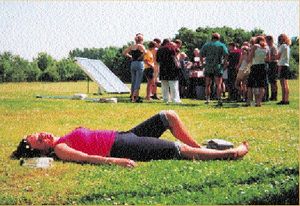
Water as a necessity of life!
3. ENERGY FOR THE NEXT MILLENIUM
Preparatory work:
- How are houses heated in your area?
- Where do the resources for heating come from?
- Are there any renewable energy supplies (wind turbines, solar energy, biogas, etc) in your area?
- What means of transport are used in your area?
Contents:
- Investigations were made to see how the football field could deliver the heating system for the host school, Sønderborg County High School (Amtsgymnasiet), through 9km of pipes placed 1m below the soil surface.
- The solar car Denmark III, which has raced the Australian plains, was presented and driven at rather high speed around the school carpark. How the solar panels made the car move was dealt with in theory.
- The participants constructed a solar kitchen stove out of a satellite dish, and served a vegetable soup.
- Experiments were made with biofuels: “Gasoline” production took place by means of grinding rapeseed, and extracting and filtering the rapeseed oil. A car with an engine specially constructed for using rape-seed oil drove on the resulting product! Rapeseed is carbon dioxide neutral – and it worked!
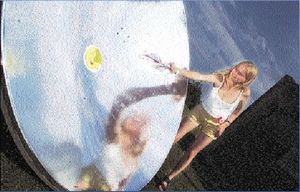
A solar kitchen was made out of a satellite dish, which was used for cooking, for example, a vegetable soup.The photo was published in the daily newspaper Politiken –here igniting into flames within seconds due to radiation heat.
4. ENVIRONMENTAL DRAMA
Preparatory work:
- Imagine yourself among other youngsters, preparing a creative performance in which the drama team criticises, questions and provokes. We choose a subject by using one of the Baltic 21 sectors as our starting point. We then plan the scenes and produce the masks, costumes and scenery sets. Rehearsals - naturally - must be done before »the grand show«.
- It is part of the workshop’s philosophy that all details, ideas and creations must be produced in close co-operation between the participants and the two drama instructors. The final result - and its success - depends on your ideas!
- Only the framework is set.The »ECO-DRAMA« will be performed on part of the pedestrian street in Sønderborg town cen-tre.The full length of the pedestrian street is approximately 400m.
- Emotionally, what do you see as the most pressing problem in connection with pollution?
- Bring some kind of documentation: a story, a newspaper cutting, a personal experience, or an object that is typical or has symbolic meaning.
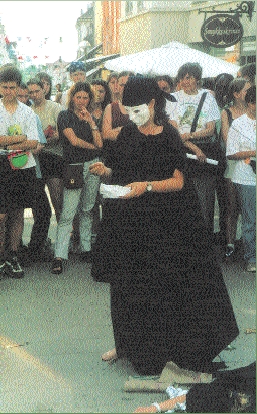
Environmental drama performance in Sønderborg’s pedestrian street
Skills needed for participation:
The work in the drama workshop was based on training specific control of mimics, gestures and body language as the platform on which a variety of simple but dynamically expressed spectacles were sculptured.
The participants must therefore have a natural desire to use their own body as an instrument for dramatic expression. Besides, it is absolutely an advantage not to be timid in participating in public performances where many people watch you »perform”.
5. IS TOURISM SUSTAINABLE
Preparatory work:
- What kind of tourism takes place in your area? Define what you understand by “sustainable tourism”!
Contents:
The participants attempted to find answers to the following questions:
- What is meant by sustainable tourism?
- What kind of activities does Sønderborg offer visitors and tourists in the town and its surroundings?
- What kind of environmental problems or conflicts might emerge from the tourist activities?
- What is the Blue Flag and what does it take to keep it?
- What can be done to achieve or develop sustainable tourism?
-Is Tourism sustainable on Als?
Study visits were made to the beach to combine two aspects: the Blue Flag and the Sandwatch project, the latter being a programme implemented as part of the UN-ESCO sister project, the Caribbean Sea Project.
The Blue Flag station near the Sønderborg yacht harbour offered perfect opportunities for snorkelling and underwater observations, and, when demanded, for publicising the frequent measurements and results from water quality investigations, such as the number of the indicator bacteria Eschericia coli. Discussions took place on how to treat and handle sewage from boats and ships, as well as problems related to polishing and painting boats.
The local camping grounds were visited for further discussions on tourist behaviour related to water consumption and waste.
Complementary activities relating to coastal tourism on the small tropical islands of the Caribbean Sea were incorporated into this workshop.
Students involved in the Caribbean Sea Project monitor different aspects of beaches on their islands, including accretion/erosion, waves and currents, pollution, types of uses (e.g. bathing, fishing, tourism), access to beaches and visitor facilities. After analysing their results, the students will design and implement projects, together with their schools and communities, to improve the environment around their beaches, both for island residents and tourists. With tourism being the main industry in many Caribbean countries, issues relating to tourism’s sustainability and impact on local cultures are critical topics that can be related to tourism in Sønderborg and the Baltic Sea countries.
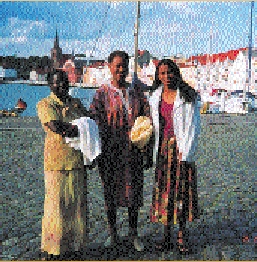
Representatives from the Caribbean Sea Project (St. Lucia) at Sønderborg Harbour
6. ART & DESIGN - A CONCEPTUAL WORKSHOP
Preparatory work:
- Imagine an apple tree, a small one, not taller than 2m high : Describe to the others HOW you would treat the apple tree. Your task is to express man’s treatment of nature in the way you treat the apple tree. Think positively as well as negatively. You may wrap, cut, exhibit, bind, etc.
- Make a similar sketch if the object was - a fish, a flower, a human being, etc.
Contents:
- The workshop used the sea, the forests, the fields and the open landscapes around Sønderborg as a background for the set design.
Participants worked in a conceptual way with their own ideas on new and transbordering layouts for a positive poster tradition.
They used themselves as actors and models in the creation of set design highlights in nature.
They used photography, computers, colour copy, artworks, paint, glue, costumes, recycled materials, cars, trees, and the beach.
- Collages, drawings, photos were made and the result was a workshop factory producing high-quality layouts for posters and postcards for future use in the BSP.
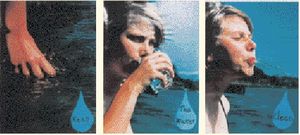
The Art & Design workshop challenged the others, asking them, “Can our products carry the Nordic Swan for environmental-friendly production?”
7. RESTORATION OF HABITATS
Preparatory work:
- Is there an example of “restoration of nature” in your local neighbourhood?
- If so, bring a description, a folder, a photo to show to the others and explain the reason.
Contents:
-
Denmark has been cultivated for thousands of years as most other countries in the Baltic region.The land has been deforested, and ponds and bogs have been dried out due to filling and drainage. Creeks and rivers have been regulated.The coastline has been changed by coastal protection and land reclamation. Pollution from traffic, tourism, industry, agriculture and forestry has altered the quality of the ground and the water. In Denmark, eutrophication is probably a greater problem than emissions of environmental poisons.
- Heather has turned into grassland, lakes and rivers have become overgrown and the fish have disappeared.
- Habitats for many plants and animals have been restricted or have disappeared.The diversity of living species has been reduced slowly but steadily, and the intricate natural food web has been disturbed.While people have become richer and richer, nature has become poorer and poorer.This process will continue unless we do something about it!
During the last decades, we have become increasingly aware of the fact that the protection and restoration of habitats are necessary if we want to stop the decrease in the diversity of living species. Protection of single species has no meaning if there is no suitable habitat left!
In this workshop, the participants studied an example of restoration of a natural habitat entitled Fjordmosen in the forest Nør-reskoven, and suggested answers to the following questions:
- Why restore natural habitats?
- Where can it be done?
- How can it be done?
- Who is involved?
- How long does it take?
- How can changes be monitored?
- How should the area be closed or open to the public?
- What do local people think of the project?
- How can it be financed?
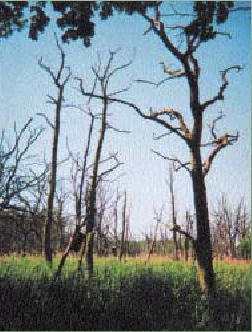
Waiting for biodiversity, Fjordmosen on Als
8. THE BALTIC SEA FOR FOOD!?
Preparatory work:
- Where do people get fish in your local area? From angling? From shops?
- What species of fish can you buy in the shops? Are the fish local, or have they been transported a long distance? Define what you understand by “sustainable fishery”.
Contents:
- The participants visited the Blue Flag Station and went snorkelling to examine the conditions and to discuss species caught in Danish coastal areas.
- Excursions were made on local fishing boats, and the catch was used for dissections of pelagic and benthic species to determine their place in the food chain.The quantity of fish and the methods of fishing were dealt with in relation to discussions on quotas and net sizes.
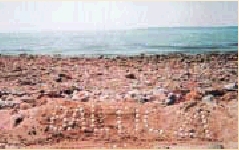
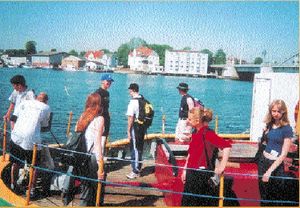
Photo competition: Among friends
9. SØNDERSKOVEN – FOREST MANAGEMENT & PRODUCTION
Preparatory work:
- What kind of forest do you have in your local neighbourhood? Make a list of trees and plants, and define what you understand by “sustainable forestry”.
Contents:
- “Sønderskoven” is a forest situated in the immediate vicinity of Sønderborg.The workshop used the wonderful facilities of the Nature School “Egetofte”, situated in the forest.The forest is right on the beach of Sønderborg Bay. Most of the trees are beech, but there are also areas with oak trees, spruces and other trees.
- Participants carried out investigations of the biodiversity of the forest floor in the beech wood, and also performed mathematical calculations on wood, measuring and gauging trees and productions.
- Severe damage to the Danish forests occurred due to an extreme hurricane on 3 December 1999. Observations of differences in damage done to deciduous trees and conifers were made and discussed.
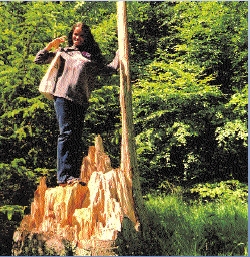
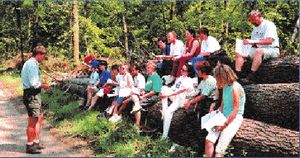
Severe damage to the Danish forests occurred due to an extreme hurricane on 3 December 1999
10. FROM RESOURCE TO PRODUCT TO RUSTY HEAPS – OR?
Preparatory work:
- What industries are there in your local area? What kind of environmental problems do they cause?
- Define what you understand by “sustainable industry”.
Contents:
-
The political goals for a sustainable industry were used in discussions with employers in Danish industries and workers’ representatives on strategies used to implement the ideas.
- Study visits were made to local factories, to JF producing agricultural machinery and to municipal waste treatment and recycling stations.The Danfoss museum was visited, Danfoss being a one-man enterprise that Denmark’s biggest industry worldwide.
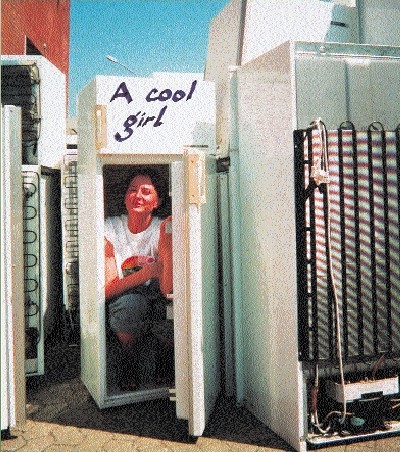
Recycling waste
– Sønderborg ASA station
11. DOCUMENTATION - VIDEO DESIGN
Preparatory work:
- Film is an effective way to spread a message. It will not just tell the facts; a film will appeal directly to the feelings of people. Reflect upon how the political goals in Baltic 21 can influence the set design of the documentary video.
Contents:
- Participants worked with the following skills:
- how to write a script
- how to videotape
- how to conduct an interview,
- how to handle a camera
- how to handle a microphone
- how to edit
They presented parts of their video to the public in the town centre.
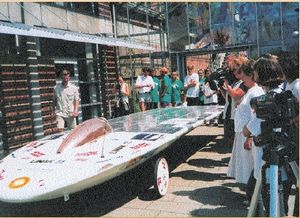
Video group at work at Amtsgymnasiet i Sønderborg (County High School) – competing with Danish national television
12. DOCUMENTATION - WEB DESIGN
Preparatory work:
- Reflect upon how you would like to document the conference through the construction of a webpage with the Baltic 21 goals as your starting point. A knowledge of English and basic computer skills are required.
Contents:
The participants worked a great deal with computers and learnt the basics of website design:
- how to format pages with HTML tables
- how to edit and adjust pictures and photos for website presentation
- how to create websites
- how to publish a CD with conference documentation.
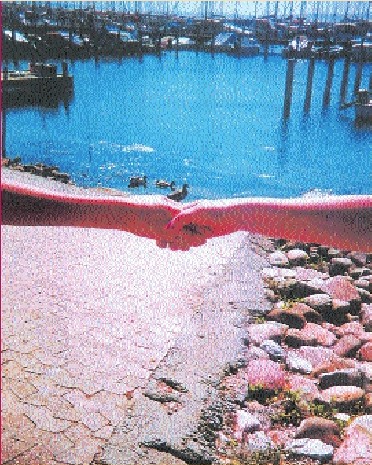
Photo competition: Among friends
13. ENVIRONMENT HAS A HISTORY - USE OF RESOURCES
Preparatory work:
- Why does the historical dimension play an important role in defining “sustainability”?
Contents:
During the last 300 years, people have completely changed the ecosystems around the Baltic Sea.
A global and industrial market economy with import of fossil fuels, fertilisers and materials has replaced the local and agricultural subsistence economy of the 18th century. With these imported goods, it is possible for the large majority of the people to live in cities and work in industry or service instead of farming in the countryside.The other side of this development is urban problems with pollution of air, pollution of water, problems in agriculture and problems in forestry with a decreasing biodiversity and eutrophication of the sea as two major consequences.
But in the 18th century fossil fuels such as coal, and industries such as ironworks and brick factories were the answers to a crisis. By using coal and iron, the people of those days tried to secure a sustainable development for the future. In the years that followed, they learned that this was not a good solution.
The participants investigated the changes in industry and urban planning over the last century in order to understand the situation of today.
The workshop contained a presentation of the following: an explanation of environmental history, A forest walk in Sönderskoven (1800-c. forestry), an excursion to Dybböl (agriculture) and Cathrinesminde (brickworks), and a citywalk in Sönderborg (town location, coastline, old town, industrialisation, German period, Danish period).
Each group dealt with one of the four themes:
- Substitution of material (Cathrinesminde)
- Urban planning (Sönderborg)
- ”Old sins” – deposit sites (Skratmosen)
- Urban industry (The Solo factory, which produced margarine from 1889 to 1998)
Our aim was to make the participants aware of the importance of: Learning from the past for the decisions of the future.
Each group examined the theme and defined the conflict as it was at the time.They then studied the history (written materials were prepared in advance) and tried to find the answer to the question: Who made the decisions and the historical premises of the decisions? From there the group discussed how the decisions would be made today.
Learning from the past for the decisions of the future

Always use a timeline in environmental history
BSP Students and Dialogue with Politicians
By Journalist Bjarke Larsen, Denmark
All the politicians from the BSP countries participating in the conference, along with most of the politicians from Sønderborg Town Council, were present in the assembly hall on Wednesday 21 June 2000, ready to answer questions and enter into a dialogue with the students.
After working with their subjects for almost three days, the students had spent some time preparing questions and were eager to get into dialogue with the politicians.
Some of the questions asked and the answers given are listed below:
 Do we know enough? Do we know enough?
Question: Do politicians get enough information about environmental
problems?
Answers:
- It differs very much. Some politicians are very active in many ways; they work in different groups and so on. Others are less active. It depends very much on the individual politician, but I think each person has a responsibility to get as much information as possible before making decisions.
- In Denmark, politicians receive a lot of information from the Ministry of the Environment, the debate in newspapers, from various interest groups and from the county.
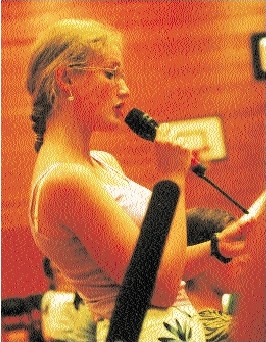
Students were eager to get into dialogue with the politicians
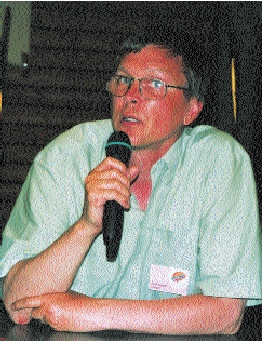
Politician Simo Korpela, Meri-Pori lukio, Finland, gives an answer
Question: What basic knowledge should politicians have for taking decisions
on the environment?
Answers:
- We cannot all be professors, and all people should be represented in city councils and other democratic institutions. Many work as politicians for their own interest and do not earn much money.
- In my opinion, politicians should have a university degree and speak at least one foreign language.
Question: How do you use the knowledge of the past to make good decisions
for the future?
Answers:
- I come from a town with a river which used to be heavily polluted with copper. But today, many things have changed, because we found out what had been put into the river in the past, and we were able to do something to clean the river.
- It is a natural part of our decision-making in the harbour where I work to look at our experiences from the past when we decide what to do for the future.
Question: Should people have special training in order to own a forest
in the same way you need special training to become a farmer?
Answers:
- In Finland, we have ’city owners’ – people who live in the cities and own a small forest as a small, part-time job.They sometimes know very little about how to take care of the forest, and this is a problem.
- I do not think it is necessary to introduce special training as long as the authorities are monitoring you and as long as there are laws and regulations telling you what is allowed.
 How to promote organic food? How to promote organic food?
Question: What can be done to create a stronger demand for organic
food?
Answers:
- Higher profits for farmers will make them interested in growing organic crops. But overly high prices will discourage consumers from buying.
- Politicians can do a lot:They can decide about prices for fuel and labour taxes and they can put taxes on pollution, etc.This all influences the prices of organic and non-organic products.
- In Finland, we have had examples of shops agreeing to take less profit for organic products in order to keep prices down.
- Consumers do not like to buy things which do not look good, are covered in brown spots, etc. And I think the organic producers have a problem here.
 Pesticides Pesticides
Question: Do you use pesticides at home yourselves?
Answers:
- Only once a year in some spots in my garden where the weeds are very bad.
- In Poland, this is not a serious problem because people do not have the money to buy pesticides.
- I am a farmer and I only use a little in my private garden.
 Metal in household garbage Metal in household garbage
Question: In Sweden, each household has to sort the garbage into separate
parts, putting metal in a special place. In Sønderborg,
you do not take the metal out of the garbage. Why is this, and
will you do something to change this?
Answers:
- In Denmark, we have very little metal in the household garbage because we do not have cans for beer and soft drinks. We only have bottles and they are collected and recycled. Because of this, there is so little metal left in household garbage that it is too expensive to collect.
 Global solutions needed Global solutions needed
Question: Why do you move chemical industry to other countries instead
of making it cleaner?
Answers:
- We cannot force them (chemical plants) to stay. If they want to move, they can do so. Therefore, it is an international problem, and we should try to get the same standards all over the world.
- We need global solutions. I know of one chemical plant that has moved several times between France and England – each time getting economic support from the government in the country they moved to, and also managing to lower the wages. It is a big problem.
 More and better fish in the Baltic More and better fish in the Baltic
Question: What will you do to improve the quality of the fish sold
in the shops?
Answers:
- Fish raised on aquafarms cause a lot of problems and should be avoided.
- Consumers should demand only very fresh fish.
Question:What is the future of in the Baltic Sea?
Answers:
- It has been going down for 20 years, rapidly. But it is very difficult to solve all the problems. One thing is sure, though: Your generation has to do more than the previous one has done.
- I come from a town in the middle of Sweden. We have a river which used to be one of the most polluted rivers running into the Baltic Sea. Lots of heavy metal in the water. But now it is being cleaned up.This will help the Baltic to become cleaner and a better place for fish.
 Money makes the world go round Money makes the world go round
Question: Which aspects are most important when making decisions about tourism: environmental, social or economic issues?
Answers:
- Money makes the world go round!
- Money decides everything, I have found out. And this is very bad.
- What politicians will you vote for: the ones giving you bread or the ones giving you clean air?
- Tourism often destroys nature. In my party in Sweden, we are trying to figure out a price to be paid by the tourist industry for using nature. But it is difficult to come up with a good solution.
The dialogue had to end at 4.45pm when the buses had to leave for the town centre in order for the students to see the drama workshop performance on the pedestrian street. Several students still had more questions ready, and it was evident that many had been very serious in their preparation for this session, and that many now had the courage to stand up in public and debate with politicians.
Resolution
- a next step towards sustainability
Resolution
Altogether, 400 students, teachers, politicians and co-ordinators from 21 countries on four continents who participated in the »On the Threshold – Baltic 21« BSP 2000 conference in Sønderborg on sustainable development in the Baltic region have adopted the following resolution. The text has been compiled by input delivered by the various workshops that each focused on one of the seven sectors within : Agriculture, Energy, Fishery, Forestry, Industry, Tourism and Transport. The text reflects what actions should be taken in the various sectors in order to ensure a sustainable development in the Baltic region in the years ahead.
Healthy Food/Novel Food
For a sustainable agriculture, we need:
- Education of farmers in handling manure and fertilisers.
- Decrease in the use of pesticides and development of sustainable methods to eradicate weeds, diseases and vermin.
- Laws for animal welfare and governmental support to the farmers to help them follow the laws.
- Education about healthy food/novel food for consumers, leading to stronger demands for organic products and making organic agriculture attractive to farmers.
Biodiversity & Green Areas
For students: Dialogue between politicians and students is very important. Invite politicians to come and see what you do and what you have on your mind. If you do not say anything, they will not know what you are thinking and feeling.
For politicians: If you have not heard anything about student efforts to preserve the environment, then go to the schools and see it for yourselves. Help them get in contact with you. Politicians must ensure that ordinary people learn about sustainable agriculture and the dangers of using fertilisers and pesticides by educating experts who can teach the people.
For all:
- Do not destroy all natural life when planning a new settlement.
- Save large amounts of different plants and animal life.
- Use compost instead of fertilisers.
- Decrease the use of pesticides and herbicides.
- Inform the people about sustainable agriculture through the media.
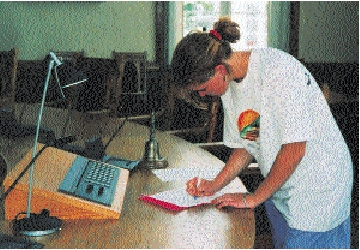
Workshop representative signing the resolution at Sønderborg Town Hall
Energy for the Next Millennium
We would like all the countries in the Baltic Sea Region to introduce one no-driving day and one no-shopping day every year in the cities.
Sustainable Tourism:
The most important thing for sustainable tourism is to achieve a balance between economics, society and environment. Tourists and tourist accommodation providers should select products and services which are least damaging to the environment: saving water and electricity, sorting waste for recycling, using eco-friendly cleaning agents, and motivating staff towards increased environmental awareness.
There should be a dialogue with the public before taking decisions about building new tourism facilities or changing old ones.
Restoration of Natural Habitats
In recent years, much has been done around the Baltic Sea to improve the environment. Nevertheless, pragmatic needs are still dominating and the role of biodiversity in our daily life is undervalued. Protection and restoration of natural habitats is part of a sustainable development. To maintain biodiversity in the world, we must accept our responsibility for the Baltic.
Therefore, we want the politicians in the Baltic to allocate resources – money as well as inspiration and practical support to volunteers – to protect and restore threatened ecosystems in the region:
- All rivers and lakes
- Swamps and meadows
- Dunes, heather and hills
- Coastal strips and archipelago
- Old forest growths
- Heritage landscapes
To fulfil the requirements of Agenda 21 on biodiversity, high-quality environmental education and a rise in public awareness is necessary on all levels.
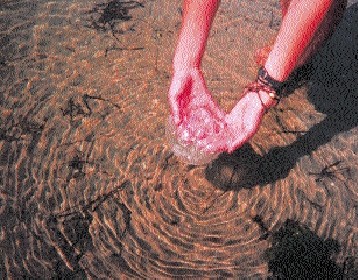
“Rings in the water”
The Baltic Sea for Food – Sustainable Fisheries
-
I want my fish to be fresh and unpolluted!
- I want to be able to fish different fish species!
- I also want future generations to be able to enjoy the beauty of the Baltic Sea and its biodiversity!
- I want future generations to be able to fish and eat the delicious fish caught in the Baltic Sea!
Forest Management
Forests beautify a country and bring unity between people and animals. Therefore, we need to keep our forests safe, beautiful and clean. This also improves the financial value of the forests. Before making decisions concerning the forests, we need be educated on ecology. More large areas should be planted with different trees to encourage biodiversity.

Poster
for public display
Sustainable Industry
People should take a first step by co-operating with producers and offering them suggestions on how to produce in a more environmentally-friendly manner.
Environmental History
We keep making the same mistakes as our parents did, and we are losing the environmental wisdom of our grandparents. Therefore, it is important to study historical cases and spread the information to all in the region. This will result in a strong connection between the past and the future, so that we do not repeat mistakes or lose the environmental wisdom of previous generations.
Signed at Sønderborg Town Hall on Thurs-day 22 June 2000 by students, teachers, co-ordinators and politicians representing all workshops.
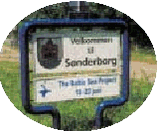

Denne side indgår i publikationen "EDUCATION FOR SUSTAINABLE DEVELOPMENT" som kapitel 4 af 8
© Undervisningsministeriet 2003
|